5.26 SP1 Maytas ESFA Release Notes
Note regarding submissions
We would like to remind providers to create a submission early and check for any errors using reports from the FIS. After submission to the ESFA, providers should check that data has submitted correctly using the available reports. Providers should check that all their expected starts and completions are submitted correctly, and that start and outcome payments correctly match the PFR.
Our support desk gets extremely busy in the days prior to the submission deadlines, and although we try and prioritise submission-related queries, we cannot guarantee assistance if queries are sent late. If you do encounter any issues, please ensure that you contact Maytas Support as soon as possible, as we can only rectify issues of which we are aware. We also recommend checking Maytas Communities regularly for information on any known issues and solutions. Tribal cannot be held responsible for any issues caused by your failure to comply with this advice.
Technical specification
The latest Maytas and Maytas Hub technical specification can be found here.
Once the upgrade has been completed, the version number should be checked to ensure it has been successful.
- Start Maytas and go to Support on the toolbar.
- Click About.
- The version numbers should read 5.26.8620.1. If you have any other version, please ensure you have followed the upgrade instructions correctly. If you require assistance, please contact Maytas Support.
It is the responsibility of customers to ensure that users carry out any required user acceptance testing and sign off on the upgrade.
Complete the Upgrade
Features Added in the Upgrade
These are the main updates in the upgrade:
- PFR Reconcilers for 2023/24
- Updated funding calculations and Financial Planning for 2023/24
- Standard Import updates
- Option to delete unused custom fields
- Reports Library 1.0.4.6
- Fixes to a number of issues
Import Funding Information
The process for importing the required funding information into Maytas is as follows:
- The latest LARS should be imported.
- The latest postcode data should be imported.
- Once all data has been imported, ensure that the funding cache is refreshed (either on a database schedule or a manual update out of working hours).
Import LARS
The LARS should be imported as follows:
- Download the latest LARS MDB file.
- In Maytas, go to Exports on the toolbar.
- On the ILR Tools panel of the ribbon, go to Uploads | Upload Funding Information | Upload LARS (Version 8 or 9).
- Browse to and select the downloaded LARS file and click Open.
- The file will now be imported. Click OK on the message which appears.
Progress on the import can be checked by going to Home | Server Tasks | Server Jobs. Typically it will take several minutes.
Import Postcode File
- Obtain the postcode uplift factors file - Download the zip file under 2023 to 2024 uplift factors by postcode and LLSOA: CSV files.
- In Maytas, go to Exports on the toolbar.
- On the ILR Tools panel of the ribbon, go to Uploads | Upload Postcodes| Upload Post Code Data (2023/24).
- Browse to and select the postcode uplifts zip file and click Open.
- The file will now be imported. Click OK on the message which appears.
Progress on the import can be checked by going to Home | Server Tasks | Server Jobs. Typically this will take several minutes.
Note on the Funding Cache
By default, the funding cache will update overnight so that funding information in Maytas uses the newly-imported FIS and postcode information. Please check with your system administrator if you are unsure if or when the funding cache is updated on your system. You can also manually set the funding cache to update by going to Management | Profiles and clicking the Funding Cache button, though please be aware that this may take a long time and may use a large amount of system resources, which could affect performance for other users on the system.
Import PFR Reconciler Reports
The PFR Reconciler reports for 2023/24 should be imported as follows:
- In Maytas, go to Home on the toolbar and click Import on the Reports panel of the ribbon.
- Click Add Files.
- Browse to the Maytas 5\Extras\Module Reports folder of the upgrade.
- Select PFR Reconcilers – 2324.m5rep and click Open.
- Click Finish.
- Once the reports have finished importing, click Finish.
Due to the size of the .rdl file for the FM36 PFR report, some report servers may produce the following error when importing:
Error: There was an exception running the extensions specified in the config file. —> Maximum request length exceeded.
This means that the report server's MaxRequestLength property is configured to only allow uploads up to a certain size, and the configuration must be changed to allow larger files to be uploaded. Please contact your system administrator to do this. Please note that Maytas Support cannot offer support on how to configure a SQL Server Report Server, as these are Microsoft products.
Maytas 5 Version 5.26.8620.1 Release Notes
PFR Reconcilers 2023/24
New PFR reconciler reports are now available to work with the 2023/24 PFR files. This year there are separate reports for funding models 35, 36 and 81 to reflect the substantially different formats of each PFR. The reports work the same as in previous years.
There are separate import options for each PFR file:
- Go to Management on the toolbar.
-
On the PFR section of the ribbon, click Upload and select the required 2023/24 PFR import option:
For FM35, go to PFR | Upload PFR (2023/24).
For FM81, go to PFR | Upload Trailblazer PFR (2023/24).
For FM36, go to FM36 Funding Reports and choose the file type to upload.
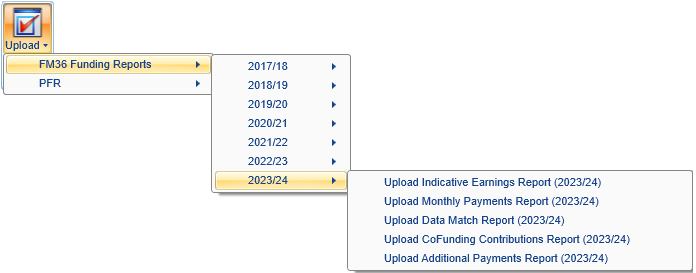
- Browse to and select the PFR file and click Open.
The file will now be imported. Click OK on the confirmation message which appears.
The PFR Reconciler reports require the 1.0.4.6 reports library upgrade SQL to have been run. Please follow the instructions below to upgrade the reports library.
Funding Model 35 PFR Reconciler Reports
The FM35 PFR reconciler reports can be accessed as follows:
- On the Home tab, click Reports Library.
- Go to the Finance folder and select one of the new reports:
- PFR Reconciler FM35 – 2324 – This shows a summary of funding differences, as well as tables showing matched rows with funding differences, rows in Maytas but not the PFR and rows in the PFR but not in Maytas.
- PFR Reconciler FM35 – Non-Funding Differences – 2324 – This shows matched rows which have differences in the non-funding columns (i.e. all columns which are not the month-by-month funding columns).
-
The parameters window will appear:
PFR – Select the PFR file from the list.
ILR file – Select the corresponding ILR file from the list.
Measure up to end of – This tells the report to only reconcile funding differences up to the end of a specific month. This is because Maytas data is highly likely to be updated in the time between the PFR being produced and the report being run – for example, leavers may be entered in Maytas who were live when the PFR was produced. This can result in inaccurate comparisons. Comparing Maytas funding data up to the period in which the PFR was produced should give a more accurate comparison than comparing current Maytas data.
Note that the following two parameters do not appear on the Non-Funding Differences report.
Show Differences Threshold (pence) – This determines the threshold in pence for the funding differences to be shown in the report. For example, the default of 10 will only include rows where there is more than a 10p total difference between Maytas and the PFR.
Show missing rows with zero values – For the section at the end of the report showing rows in the PFR but not in the Maytas ILR export (and vice-versa), this allows you to hide rows which have no funding against them. By default, these rows are included.
- Click View to run the report.
There is one new column on the report: Earnings boost category.
Funding Model 81 PFR Reconciler Reports
The FM81 PFR reconciler reports can be accessed as follows:
- On the Home tab, click Reports Library.
- Go to the Finance folder and select one of the new reports:
- PFR Reconciler FM81 – 2324 – This shows a summary of funding differences, as well as tables showing matched rows with funding differences, rows in Maytas but not the PFR and rows in the PFR but not in Maytas.
- PFR Reconciler FM81 – Non-Funding Differences – 2324 – This shows matched rows which have differences in the non-funding columns (i.e. all columns which are not the month-by-month funding columns).
- The parameters window will appear:
PFR – Select the PFR file from the list.
ILR file – Select the corresponding ILR file from the list.
Measure up to end of – This tells the report to only reconcile funding differences up to the end of a specific month. This is because Maytas data is highly likely to be updated in the time between the PFR being produced and the report being run – for example, leavers may be entered in Maytas who were live when the PFR was produced. This can result in inaccurate comparisons. Comparing Maytas funding data up to the period in which the PFR was produced should give a more accurate comparison than comparing current Maytas data.
Note that the following two parameters do not appear on the Non-Funding Differences report.
Show Differences Threshold (pence) – This determines the threshold in pence for the funding differences to be shown in the report. For example, the default of 10 will only include rows where there is more than a 10p total difference between Maytas and the PFR.
Show missing rows with zero values – For the section at the end of the report showing rows in the PFR but not in the Maytas ILR export (and vice-versa), this allows you to hide rows which have no funding against them. By default, these rows are included.
- Click View to run the report.
There are no column changes from the 2022/23 report.
Funding Model 36 PFR Reconciler Reports
The FM36 PFR reconciler reports can be accessed as follows:
- On the Home tab, click Reports Library.
- Go to the Finance folder and select one of the new reports:
- PFR Reconciler FM36 – 2324 – This shows a summary of funding differences, as well as tables showing matched rows with funding differences, rows in Maytas but not the PFR and rows in the PFR but not in Maytas.
- PFR Reconciler FM36 – Non-Funding Differences – 2324 – This shows matched rows which have differences in the non-funding columns (i.e. all columns which are not the month-by-month funding columns).
-
The parameters window will appear:
Report type – This lets you choose whether to reconcile the indicative earnings report, the monthly payments report or the co-investment payments report. Each of these will determine the available PFR files to select from and the content displayed when the report is run.
PFR – Select the PFR file from the list.
ILR file – Select the corresponding ILR file from the list.
Measure up to end of – This tells the report to only reconcile funding differences up to the end of a specific month. This is because Maytas data is highly likely to be updated in the time between the PFR being produced and the report being run – for example, leavers may be entered in Maytas who were live when the PFR was produced. This can result in inaccurate comparisons. Comparing Maytas funding data up to the period in which the PFR was produced should give a more accurate comparison than comparing current Maytas data.
Note that the following two parameters do not appear on the Non-Funding Differences report.
Show Differences Threshold (pence) – This determines the threshold in pence for the funding differences to be shown in the report. For example, the default of 10 will only include rows where there is more than a 10p total difference between Maytas and the PFR.
Show missing rows with zero values – For the section at the end of the report showing rows in the PFR but not in the Maytas ILR export (and vice-versa), this allows you to hide rows which have no funding against them. By default, these rows are included.
- Click View to run the report.
The FM36 PFR reconciler can be run against four different PFR datasets for FM36: indicative earnings, monthly payments, co-investment payments and additional payments. This can be chosen in the Report type parameter.
Of these options, we expect the indicative earnings report to match the Maytas figures the closest, as this PFR data does not depend on certain factors which must be assumed in Maytas (these factors are not available and cannot be derived before the PFR data is produced). The monthly and co-investment payments reports do depend on these factors and so are likely to match the Maytas figures less closely. In very broad terms, the indicative earnings are the 'expected' figures and the payment reports are the actual figures.
On the monthly payments view, the new column Employer name at start of price episode has been added. Otherwise there are no column changes from the 2022/23 report.
Financial Planning 2023/24
The Financial Planning module now supports plans for 2023/24. After the upgrade, it is important to ensure the funding cache has been updated. In most cases this should be done automatically on a schedule (check with your system administrator), but it can also be done manually by going to Management | Profiles and clicking the Funding Cache button. This may take a long time and may use a lot of system resources, so it is strongly recommended to only update the funding cache outside of normal working hours.
To create a 2023/24 plan:
- Go to Management | Financial Plans.
- Double-click New Financial Plan.
- Select a 2023/24 contract to base the plan on and click Next.
- Enter a name for the plan and click Next.
- Select the funding models and funding line types you wish to use for the plan and click Next.
- Select the years and periods you wish to use for the plan and click Next.
- Click Finish.
The plan will now be created.
Before using any existing plans from 2022/23 and earlier, you should refresh their current data values and what if values. This can be done on each required plan by going to the Current Data Values and What If Values tabs and clicking the  button.
button.
FE Workforce 2022/23
The FE Workforce export has been updated for the 2022/23 specification. Additionally, FE Workforce data in Maytas has been migrated to the 2022/23 format as per the data migration specification.
Standard Import Updates
Files and user in log
The Standard Import database log now records the files that were used in an import and the user who performed the import. This can be found in the STDIMPORT_LOG table, with the details stored in the LOGDETAILS column. An example log would appear as follows:
Csv File = 'C:\Files\Example import data.xlsx' and Con File = 'C:\Files\Example import data.CON' by user = 1 : ADMIN
Sub folders for watchers
When entering the folder that a standard import watcher should check for files to import, sub folders can now be specified by using a backslash (e.g. Watchers\Folder1 and Watchers\Folder2).
Deletion of Unused Custom Fields
Custom fields, i.e. those which begin with U_ in the database, can now be removed via Maytas if every row for that field is null. This requires a permission to be set:
- Go to Tools | Edit Permissions.
- Select the user or group which requires permission.
- Go to the Commands tab.
- Expand the Lookup Editor section.
- Set the Delete Field permission to Visible.
- Click Apply and restart Maytas for the change to take effect.
To delete an unused custom field:
- Go to Tools | DB Schema.
- Expand the relevant table on the left and select the U_ field you wish to delete.
-
Click Remove Field on the ribbon.
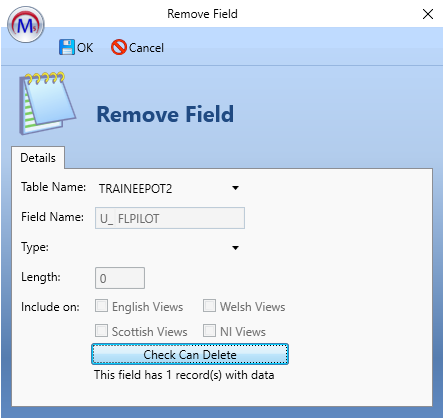
- Click the Check Can Delete button. If there are any records with data in the field (i.e. where the field is not null), this will be indicated under the button and you will not be able to click the OK button to remove the field.
-
If you decide to remove any data from the field, click the Check Can Delete button again once the data has been removed. It will now indicate that the field is not used.
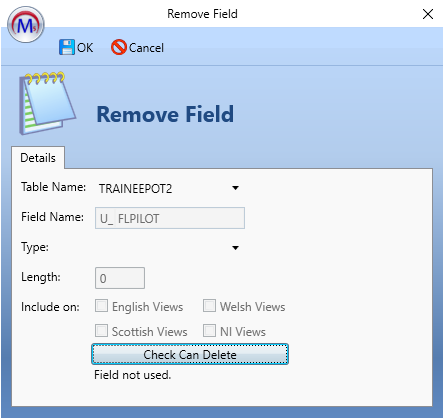
- Click OK to delete the field (or click Cancel to abort).
DfE Updates
DfE API V3 updates
Maytas now utilises version 3 of the DfE API, which includes updates for additional tables and columns. The API URL should be updated to V3 in the configuration options:
- Click the M5 button at the top left and select Options.
- Go to Other on the left (in the Maytas 5 section) and locate the DFE section on the right.
- In the Url for API config, ensure that the end of the URL is updated to v3.
- Click OK.
The following new columns are included on the DfE Data tab:
-
Withdrawal Reason
-
Withdrawal Date
-
Deferral Reason
-
Deferral Date
-
Delivery Partner ID
-
ITT Provider
-
Private Childcare Provider URN
-
Training Record ID
-
Lead Mentor
There are also several new tables in the Maytas database which are updated from the DfE:
-
DFE_ECF_ENROLMENT
-
DFE_DELIVERYPARTNER
-
DFE_DELIVERYPARTNER_COHORT
-
DFE_PARTNERSHIP
-
DFE_SCHOOL
-
DFE_SCHOOL_COHORT
-
DFE_STATEMENT
-
DFE_PARTICIPANT_TRANSFER
When getting updates, ECF enrolments will now become separate POTs for an ECF learner in Maytas, whereas previously only one POT would be created. Each enrolment will have a unique value in DFE_ECF_ENROLMENT.TRAINING_RECORD_ID which links to TRAINEEPOT2.DFE_TRAINING_RECORD_ID.
Delivery partners
Assessor records in Maytas will be generated from delivery partner records in the DfE. The following new fields have been added to the ASSESSOR table:
-
U_FULL_NAME
-
DFE_DELIVERY_PARTNER_ID
When getting updates, Maytas will try to match the delivery partner full name to an existing assessor. If a record is found with a matching name but no DFE_DELIVERY_PARTNER_ID, the ID field will be updated. If no matching record is found, a new assessor record will be created.
A DFE Data tab for assessors is also available. The tab must first be published:
- Go to Tools on the toolbar.
- Click Publish / Unpublish on the Screens panel of the ribbon.
- Locate the two screen called DFE Datafor the ASSESSOR table and ensure the Published box is ticked.
- Click Finish.
- Go to Home on the toolbar and click Sync.
The tab shows the assessor's full name and delivery partner ID from the DfE, as well as their cohort information (this is a calculated field which amalgamates the assessor's data from the DFE_DELIVERYPARTNER_COHORT table).
Schools
Employer records in Maytas will be generated from school records in the DfE.
The first update on V3 will likely take a long time to download school data from the DfE as there are over 26,000 records, each with up to 3 cohorts.
The following new fields have been added to the EMPLOYER table:
-
DFE_SCHOOLID
-
DFE_URN
-
DFE_COHORT
-
DFE_IN_PARTNERSHIP
-
DFE_INDUCTION_PROGRAMME_CHOICE
When getting updates, Maytas will try to match school records on the school ID. If no match is found, it will try to match on the employer name. If a match is found on the employer name and there is no school ID, the ID field will be updated. If no matching record is found, a new employer record will be created.
A DFE Data tab for employers is also available. The tab must first be published:
- Go to Tools on the toolbar.
- Click Publish / Unpublish on the Screens panel of the ribbon.
- Locate the two screen called DFE Datafor the EMPLOYER table and ensure the Published box is ticked.
- Click Finish.
- Go to Home on the toolbar and click Sync.
The tab shows the employer's school name, school ID, URN, induction programme choice and partnership from the DfE, as well as their cohort information (this is a calculated field which amalgamates the employer's data from the DFE_SCHOOL_COHORT table).
Partnerships
Partnerships are links between delivery partners and schools, which are represented in Maytas in the EMPASSESSOR table (which links assessors to employers).
Status fields
In previous versions, all participants used the DFE Status field on the DFE Data tab to show their status. This has changed so that NPQ participants continue to use the DFE Status field, whereas ECF participants use the DFE Participant Status field.
NPQ participants - change cohort
When managing courses for NPQ participants, the cohort year can now be changed:
- Open a learner record and go to Actions | DFE | Manage Course.
-
Select the year from the Cohort dropdown box.
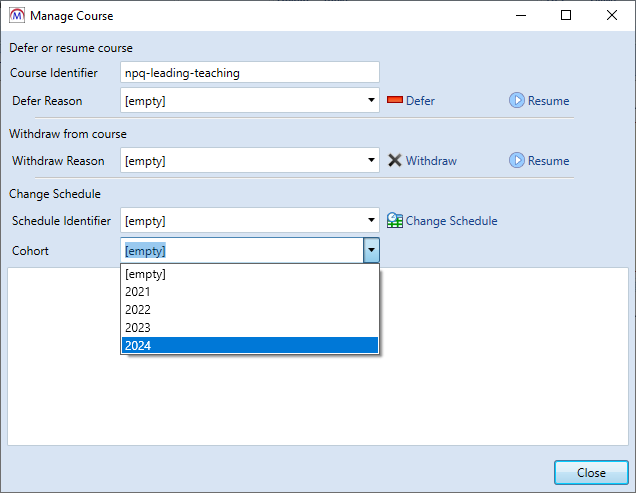
- Click Close.
Schedule Get Updates process
The Scheduler now allows you to schedule DfE updates:
- Go to Tools | Scheduler.
- Click New on the ribbon and select DfE Updates.
-
A new DfE item will appear in the tree view on the left. Click it to bring up its details on the right.
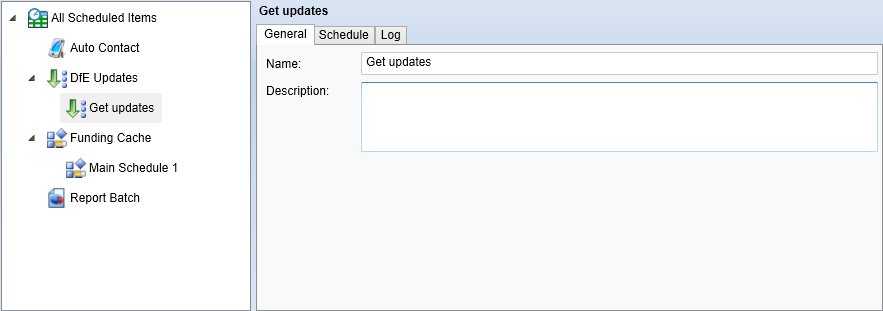
- Enter a name and (optionally) a description on the General tab.
-
Go to the Schedule tab. This is where you can configure when (and how often) the schedule will run.
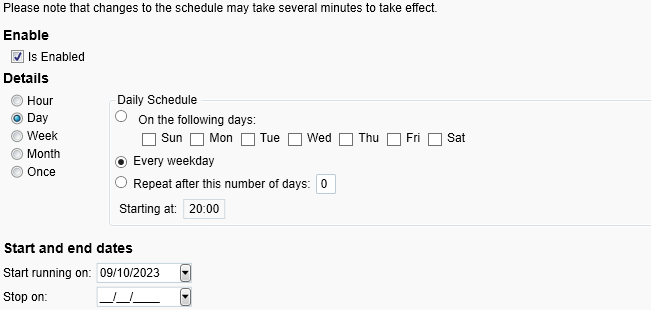
-
Set the schedule in the Details section. It can be set to run periodically (e.g. every day, week, etc) or just once at a specified time. Please note that if you intend to start the schedule immediately, the start time should be at least 10 minutes in the future to ensure it is picked up by the system.
-
Set the start date at the bottom of the window. The schedule will run indefinitely by default, but if you want the schedule to end on a particular date then tick the Stop on box and set the date.
-
When you have finished configuring the schedule and want to activate the schedule, tick the Is Enabled box at the top of the tab.
-
Click Apply on the ribbon to save the schedule.
The Log tab shows a log of when the schedule has been run, which can be filtered between two dates.
There is also a configuration option which allows you to specify how many days to backdate when getting updates from the DfE:
- Click the M5 button at the top left and select Options.
- Go to Other on the left (in the Maytas 5 section) and locate the DFE section on the right.
- Ensure the box for the Schedule Backdate option is ticked, then enter the number of days to backdate.
- Click OK.
Skills Forward Update
A new option has been added to the Skills Forward integration which will download all results, including those which have already been downloaded.
-
Go to Management on the toolbar.
-
Click Skills Forward on the ribbon and select Get Results (include processed).
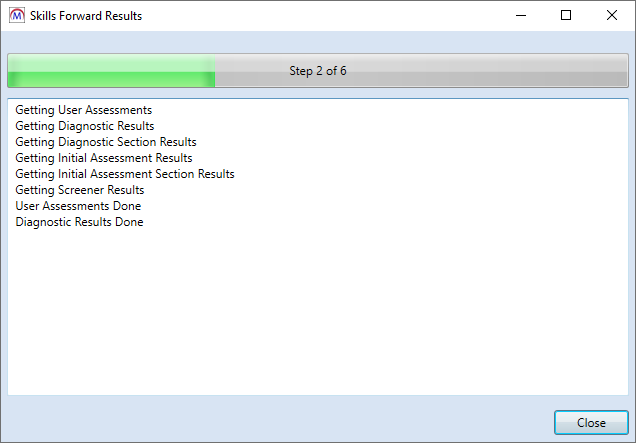
-
All results will now be downloaded.
The existing Get Results option continues to work as before, only downloading results that have not previously been downloaded.
Reports Library 1.0.4.6
Upgrade the Reports Library
How to Upgrade the Reports Library
The Reports Library upgrade should be performed by an admin user, which will upgrade the reports for all users.
To enable to the Upgrade reports button for an admin user:
- Go to Tools | Edit Permissions.
- Select the user or group which requires permission.
- Go to the Commands tab.
- Expand the Support section.
- Set the Report SQL Upgrade permission to Visible.
- Click Apply and restart Maytas for the change to take effect.
For customers who manage their own systems on-premise, it is strongly advised to take a database backup before performing the upgrade. This is not necessary for hosted customers as backups are taken regularly.
To upgrade the Reports Library:
- Go to Support on the toolbar.
-
Click Upgrade reports.

- You will asked to confirm that you wish to perform the reports upgrade SQL. Click OK to continue.
- A message will appear saying that a task has been created. Click OK.
-
You can check that the upgrade was successful by going to Home on the toolbar and then selecting Server Tasks | View Jobs.

If the Status indicates that the upgrade has failed, please do not continue with importing the reports package and raise an incident on theSelf Support Portalfor assistance.
- Next, the reports package must be imported. Go to Home on the toolbar and click Import on the Reports panel on the ribbon.
- This will display the Report Import wizard. Click +Add Files.
- Browse to the Maytas 5\Extras\Reports Library folder of the upgrade, select one of the following packages and click Open:
- For all reports, select Reports Library 1.0.4.6 (all reports).
- For ESFA and general reports only, select Reports Library 1.0.4.6 (ESFA and general reports).m5rep.
- Click Finish to import the reports. This process may take a long time (potentially upwards of 30 minutes) depending on the size of the reports package.
-
When the reports have finished importing, click Finish.
The import log may display various warning messages, which are generally a result of report formatting and other factors which do not impact how a report runs (e.g. The text box ‘textbox3’ extends beyond the bottom edge of its container.). Unless a message indicates that the import has failed, these warnings can safely be ignored.
New Report - Data Changes
The Data Changes report shows a list of changes by users in a date and time range from both Maytas 5 and Maytas Hub. This is based on data in the M32$_WEB_USERCHANGES table, though not everything from that table is shown (e.g. internal changes such as funding cache updates are not shown). The results in the report are data changes performed by users, such as creating or deleting a learner record, directly editing a field or importing data via the Standard Import system.
The Data Changes report can be found in the Audit folder of the Reports Library.
The Data Changes report shows a wide range of user-specific data. As such, it is strongly recommended to review and limit access to the report as required.
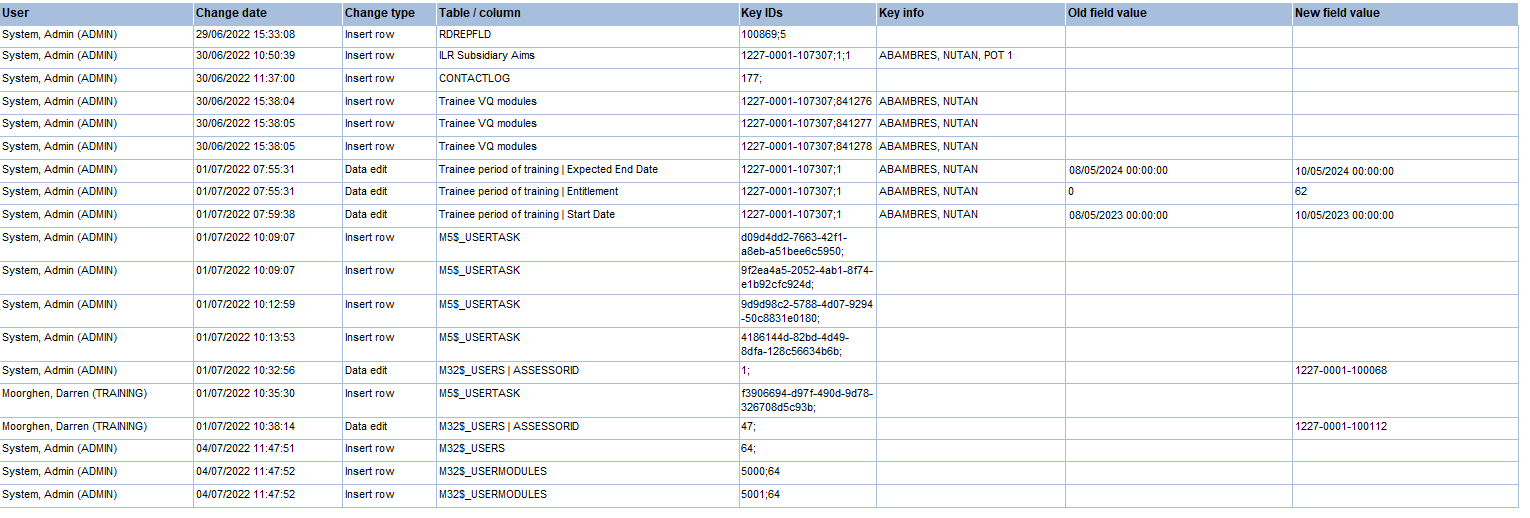
Parameters
-
From / To date - The date range to show in the report. Both dates default to the previous day.
-
From / To hour / minute - These allow you to narrow the date range by time. The defaults are from 00:00 to 23:59 (i.e. the full day).
-
User type - Whether to show Maytas 5 users, Maytas Hub users or both.
-
Include disabled accounts - Whether to show results for user accounts that have been disabled.
-
Users - Allows you to filter by specific users.
-
User actions to show - Allows you to specify which of the three user actions (data edit, insert row and delete row) to show.
-
Learners - Allows you to filter by specific learners.
-
Tables - Allows you to filter by changes to specific tables.
-
Show descriptive table / column names where available - Toggles whether to show table names as stored in the database or their descriptive names where available (e.g. TRAINEE vs Trainee Basic Details).
-
Ready to run - Set this to Yes when all other parameters have been set as required.
Results columns
-
User - The user who performed the change.
-
Change date - The date and time of the change.
-
Change type - Whether the data change was newly created (insert row), removed (delete row) or an alteration (data edit).
-
Table / column - The table and column relating to the change. The column is only displayed for data edits, as insert and delete changes refer to an entire row being added or removed from a table, not a change to a specific column.
-
Key IDs - These display the key identifiers for the relevant table, which can be used to perform further investigation outside of the report if required.
-
Key info - Where applicable, learner, assessor and employer names are displayed here.
-
Old / New field value - For data edits, these show what the data has changed from and to. Note that the report results do not distinguish between null and blank values.
Apprenticeship Accountability Framework report - Merge multiple POTs into single programme
The Apprenticeship Accountability Framework report will now by default merge multiple POTs from planned breaks / restarts into a single programme in the results. This can be toggled with the Merge planned break / restart POTs into a single record parameter.
This feature is implemented in the Withdrawals, Off the job training, Learners past planned end date and End point assessment organisation data measures, so that programmes that have restarted are not counted more than once.
The feature is not implemented in the Achievement rates, Retention rates and Breaks in learning measures, as these have their own specific rules for how breaks / restarts are measured and presented.
POTs are merged into a single programme by first identifying POTs where the programme aim completion status is 6 or the restart indicator is 1. These POTs are then matched as part of the same programme on ULN, learner reference number, UKPRN and framework or standard code. The following data is then used in the measures:
| Field | Data used |
|---|---|
| POT | Latest POT in the programme (based on start date) |
| Start date | Earliest programme start date of all POTs in the programme |
| Planned end date | Latest programme planned end date of all POTs in the programme |
| Actual end date | Latest programme actual end date of all POTs in the programme |
| Completion status | Latest programme completion status of all POTs in the programme |
QAR 2022/23 Rulesets
The QAR rules for apprenticeships, traineeships and education and training (ET) have been implemented based on the specifications for 2022/23.
Learner List Report - Gateway Learners
The Learner List Report has a new parameter, Include Gateway learners in In Learning category. When set to No, the In Learning learner type will work as before (i.e. only learners in learning at any point in the specified date range will be included).
When set to Yes, learners with the following data will be included in the In Learning learner type, even if the POT termination date is before the date range:
-
Programme aim funding model = 36
-
Programme aim completion status = 1 or not entered
-
Programme aim outcome = 8
This feature also applies to the Learner List Summary Report.
Provider Summary Report - Standards
The Provider Summary Report has been updated to include apprenticeship standards as a grouping and filter option, based on the programme aim standard code.